Effect of Baffles in Flow Channel on the Performance of Vanadium Redox Flow Battery
Abstract
:1. Introduction
2. Mathematic Formulas and Numerical Modeling
2.1. Geometry Parameter
2.2. Assumptions
2.3. Mathematic Formulas [10]
2.4. Boundary Conditions
2.5. Numerical Method
3. Experimental Method
3.1. Experimental Instrument
3.2. VRFB Experimental Composition
3.3. VRFB Charge-Discharge Curve Test
4. Results and Discussion
4.1. Impact of Baffle Height on Charge/Discharge Voltage and Concentration Distribution of the VRFB
4.2. Effect of Design Case with Voltage of the VRFB
4.3. Experimental Analysis for the VRFB
4.4. Impact of Current Density
4.5. Effect of Flow Rates
4.6. Comparison between the Three Types of VFRB Efficiency
5. Conclusions
- The baffle height of 0.9 h has the lowest terminal voltage by about 1.101 V at the discharge process. It is lower than the smooth by about 2.5 mV.
- For the number of baffles with 9, the terminal voltage at the discharging process is lower than the single baffle row, which is about 2.2 mV. This result shows that the charging efficiency increases and the internal loss declines.
- The terminal voltage for Case 4 is lower than for Case 2 by about 2 mv. Furthermore, Case 4 has a lower terminal voltage against the smooth channel by about 7.5 mv. The battery performance increases with setting the baffles in the 1st, 9th, and 17th rows. In contrast to the other cases, Case 4’s baffles promote ion transfer and cause mass transport.
- As the current density increases, the Coulombic efficiency improves. Because the charge and discharge cycle is quicker with a larger current per area, the battery has a better charge agreement. Furthermore, the voltage efficiency drops as the current density rises because of an ohmic drop during the discharging process.
- The velocity impacts how long the charge and discharge process takes when comparing the operating voltage for the VRFB at 300 mL/min and 100 mL/min. The VRFB’s higher capacity is the cause of the longer cycle time. Different flow rates can alter the voltage at which the charge/discharge process starts. With an increase in volume rate, the energy efficiency slightly climbs.
- The best condition occurs at the lower current density (40 mA/cm2) and flows velocity set at 300 mL/min. In addition, against the smooth flow field, case 4 has the highest energy efficiency of about 81.12%, which increased by about 4.5%.
Author Contributions
Funding
Institutional Review Board Statement
Informed Consent Statement
Data Availability Statement
Acknowledgments
Conflicts of Interest
Nomenclature
| A | Specific area () | |
| B | Fixed bias error | |
| c | Molar concentration () | |
| CE | Columbic efficiency | |
| D | Diffusivity of vanadium ions () | |
| E | Equilibrium potential (V) | |
| EE | Energy efficiency | |
| F | Faraday’s coefficient (96478, ) | |
| fe | Function of the degrees of freedom | |
| h | Channel height (mm) | |
| i | Exchanging current per area () | |
| Ich | Charging current (A) | |
| Idis | Discharging current (A) | |
| k | Reaction rate coefficient () | |
| Molar flux of species i | ||
| Nt | Total number of case | |
| n | Number | |
| unit normal vector | ||
| P | Pressure (Pa) | |
| Rd | Dissociation rate of HSO4 () | |
| R | Gas constant (8.314, ) | |
| S | Source item | |
| T | Temperature (K) | |
| Tch | Charging time (s) | |
| Tdis | Discharging time (s) | |
| U | Uncertainty | |
| Velocity vectors () | ||
| Vch | Averaged charging voltage (V) | |
| Vdis | Averaged discharging voltage (V) | |
| VE | Voltage efficiency | |
| Inlet velocity | ||
| z | Charge number | |
| Greek symbols | ||
| α | Transfer coefficient | |
| γk | Precision error | |
| δk | Total error | |
| ε | Porosity | |
| η | Over-potential | |
| μ | Dynamic viscosity | () |
| ρ | Density of fluid () | |
| σ | Effective conductivity () | |
| Φ | Potential (V) | |
| Superscript | ||
| eff | Effective property | |
| pos | Positive electrode | |
| neg | Negative electrode | |
| 0 | Standard condition | |
| s | Compared with surface | |
| T | Transposed | |
| t | Terminal | |
| Subscript | ||
| H+ | Protons | |
| SO42- | Sulphate ions | |
| HSO4- | Hydrogen sulphate ions | |
| i | i-th chemical species | |
| l | Liquid phase | |
| m | Membrane | |
| s | Solid phase | |
| e | Electrolyte | |
| + | Ion | |
References
- Sun, C.; Negro, E.; Vezzu, K.; Pagot, G.; Cavinato, G.; Nale, A.; Bang, Y.H.; Di Noto, V. Hybrid inorganic-organic proton-conducting membranes based on SPEEK doped with WO3 nanoparticles for application in vanadium redox flow batteries. Electrochim. Acta 2019, 309, 311–325. [Google Scholar] [CrossRef]
- Iwakiri, I.; Antunes, T.; Almeida, H.; Sousa, J.P.; Figueira, R.B.; Mendes, A. Redox Flow Batteries: Materials, Design and Prospects. Energies 2021, 14, 5643. [Google Scholar] [CrossRef]
- Di Noto, V.; Vezzu, K.; Crivellaro, G.; Pagot, G.; Sun, C.Y.; Meda, L.; Rutkowska, I.A.; Kulesza, P.J.; Zawodzinski, T.A. A general electrochemical formalism for vanadium redox flow batteries. Electrochim. Acta 2022, 408, 139937. [Google Scholar] [CrossRef]
- Yue, M.; Lv, Z.; Zheng, Q.; Li, X.; Zhang, H. Battery assembly optimization: Tailoring the electrode compression ratio based on the polarization analysis in vanadium flow batteries. Appl. Energy 2019, 235, 495–508. [Google Scholar] [CrossRef]
- Brown, L.D.; Neville, T.P.; Jervis, R.; Mason, T.J.; Shearing, P.R.; Brett, D.J.L. The effect of felt compression on the performance and pressure drop of all-vanadium redox flow batteries. J. Energy Storage 2016, 8, 91–98. [Google Scholar] [CrossRef]
- Tain, H.; Chein, R.Y.; Hsueh, K.L.; Wu, C.H.; Tsau, F.H. Design and modeling of electrolyte pumping power reduction in redox flow cells. Rare Met. 2011, 30, 6–21. [Google Scholar]
- Karrech, A.; Regenauer-Lieb, K.; Abbassi, F. Vanadium flow batteries at variable flow rates. J. Energy Storage 2022, 45, 103623. [Google Scholar] [CrossRef]
- Lallo, E.; Khataee, A.; Lindstroem, R.W. Vanadium Redox Flow Battery Using Aemi-on™ Anion Exchange Membranes. Processes 2022, 10, 270. [Google Scholar] [CrossRef]
- Aaron, D.S.; Liu, Q.; Tang, Z.; Grim, G.M.; Papandrew, A.B.; Turban, A.; Zawodzinski, T.A.; Mench, M.M. Dramatic performance gains in vanadium redox flow batteries though modified cell architecture. J. Power Sources 2012, 206, 450–453. [Google Scholar] [CrossRef]
- Xu, Q.; Zhao, T.S.; Leung, P.K. Numerical investigations of flow field designs for vanadium redox flow batteries. Appl. Energy 2012, 105, 47–56. [Google Scholar] [CrossRef]
- Xu, Q.; Zhao, T.S.; Zhang, C. Performance of a vanadium redox flow battery with and without flow fields. Electrochim. Acta 2014, 142, 61–67. [Google Scholar] [CrossRef]
- Ke, X.; Prahl, J.M.; Alexander, J.I.; Savinell, R.F. Mathematical modeling of electrolyte flow in a segment of flow channel over porous electrode layered system in vanadium flow battery with flow field design. Electrochim. Acta 2017, 233, 124–134. [Google Scholar] [CrossRef]
- Maurya, S.; Nguyen, P.T.; Kim, Y.S.; Kang, Q.; Mukundan, R. Effect of flow field geometry on operating current density, capacity and performance of vanadium redox flow battery. J. Power Sources 2018, 404, 20–27. [Google Scholar] [CrossRef]
- Latha, T.J.; Jayanti, S. Ex-situ experimental studies on serpentine flow field design for redox flow battery systems. J. Power Sources 2014, 248, 140–146. [Google Scholar] [CrossRef]
- Huang, Z.B.; Mu, A.L. Flow field design and performance analysis of vanadium redox flow battery. Ionics 2021, 27, 5207–5218. [Google Scholar] [CrossRef]
- Ke, X.; Prahl, J.M.; Alexander, J.I.D.; Savinell, R.F. Redox flow batteries with serpentine flow fields: Distributions of electrolyte Flow reactant penetration into the porous carbon electrodes and effects on performance. J. Power Sources 2018, 384, 295–302. [Google Scholar] [CrossRef]
- Ke, X.; Prahl, J.M.; Alexander, J.I.D.; Savinell, R.F. A Simple Analytical Model of Coupled Single Flow Channel over Porous Electrode in Vanadium Redox Flow Battery with Serpentine Flow Channel. J. Power Sources 2015, 288, 308–313. [Google Scholar] [CrossRef]
- Messaggi, M.; Canzi, P.; Mereu, R.; Baricci, A.; Inzoli, F.; Casalegno, A.; Zago, M. Analysis of flow field design on vanadium redox flow battery performance: Development of 3D computational fluid dynamic model and experimental validation. Appl. Energy 2018, 228, 1057–1070. [Google Scholar] [CrossRef]
- Gundlapalli, R.; Jayanti, S. Dataset on performance of large-scale vanadium redox flow batteries with serpentine flow fields. Data Brief 2021, 35, 106835. [Google Scholar] [CrossRef]
- Tsai, B.T.; Tseng, C.J.; Liu, Z.S.; Wang, C.H.; Lee, C.I.; Yang, C.C.; Lo, S.K. Effects of flow field design on the performance of a PEM fuel cell with metal foam as the flow distributor. Int. J. Hydrogen Energy 2012, 37, 13060–13066. [Google Scholar] [CrossRef]
- Kerkoub, Y.; Benzaoui, A.; Haddad, F.; Ziari, Y.K. Channel to rib width ratio influence with various flow field designs on performance of PEM fuel cell. Energy Convers. Manag. 2018, 174, 260–275. [Google Scholar] [CrossRef]
- Huang, C.M.; Shy, S.S.; Li, H.H.; Lee, C.H.T. The impact of flow distributors on the performance of planar solid oxide fuel cell. J. Power Sources 2010, 195, 6280–6286. [Google Scholar] [CrossRef]
- Zhao, C.; Yang, J.J.; Zhang, T.; Yan, D.; Pu, J.; Chi, B.; Li, J. Numerical modeling of manifold design and flow uniformity analysis of an external manifold solid oxide fuel cell stack. Int. J. Hydrogen Energy 2020, 45, 14440–14451. [Google Scholar] [CrossRef]
- Liu, H.C.; Yana, W.M.; Soong, C.Y.; Chen, F. Effects of baffle-blocked flow channel on reactant transport and cell performance of a proton exchange membrane fuel cell. J. Power Sources 2005, 142, 125–133. [Google Scholar] [CrossRef]
- Gu, H.W.; Wu, H.W. Effects of modified flow field on optimal parameters estimation and cell performance of a proton exchange membrane fuel cell with the Taguchi method. Int. J. Hydrogen Energy 2012, 37, 1613–1627. [Google Scholar]
- Perng, S.W.; Wu, H.W. A three-dimensional numerical investigation of trapezoid baffles effect on non-isothermal reactant transport and cell net power in a PEM fuel cells. Appl. Energy 2015, 143, 81–95. [Google Scholar] [CrossRef]
- Wu, H.W.; Ho, T.Y.; Ha, Y.J. Parametric optimization of wall-mounted cuboid rows installed in interdigitated flow channel of HT-PEM fuel cells. Energy 2021, 216, 119261. [Google Scholar] [CrossRef]
- Dickinson, E.J.F.; Wain, A.J. The Butler-Volmer equation in electrochemical theory: Origins, value, and practical application. J. Electroanal. Chem. 2020, 872, 114145. [Google Scholar] [CrossRef]
- Knehr, W.; Kumbur, E.C. Open circuit voltage of vanadium redox flow batteries: Discrepancy between models and experiments. Electrochem. Commun. 2011, 13, 342–345. [Google Scholar] [CrossRef]
- Available online: https://www.itri.org.tw/english/ (accessed on 7 November 2022).
- Sun, C.Y.; Negro, E.; Nale, A.; Pagot, G.; Vezzu, K.; Zawodzinski, T.A.; Meda, L.; Gambaro, C.; Di Noto, V. An efficient barrier toward vanadium crossover in redox flow batteries: The bilayer [Nafion/(WO3)(x)] hybrid inorganic-organic membrane. Electrochim. Acta 2021, 378, 138133. [Google Scholar] [CrossRef]
- Incropra, F.P.; Lavine, A.S.; Bergman, T.L.; DeWitt, D.P. Fundamentals of Heat and Mass Transfer; John Wiley and Sons Inc.: Hoboken, NJ, USA, 2011. [Google Scholar]
- Abernethy, R.B.; Benedict, R.P.; Dowdell, R.B. ASME Measurement Uncertainty. J. Fluids Eng. 1985, 107, 161–164. [Google Scholar] [CrossRef] [Green Version]
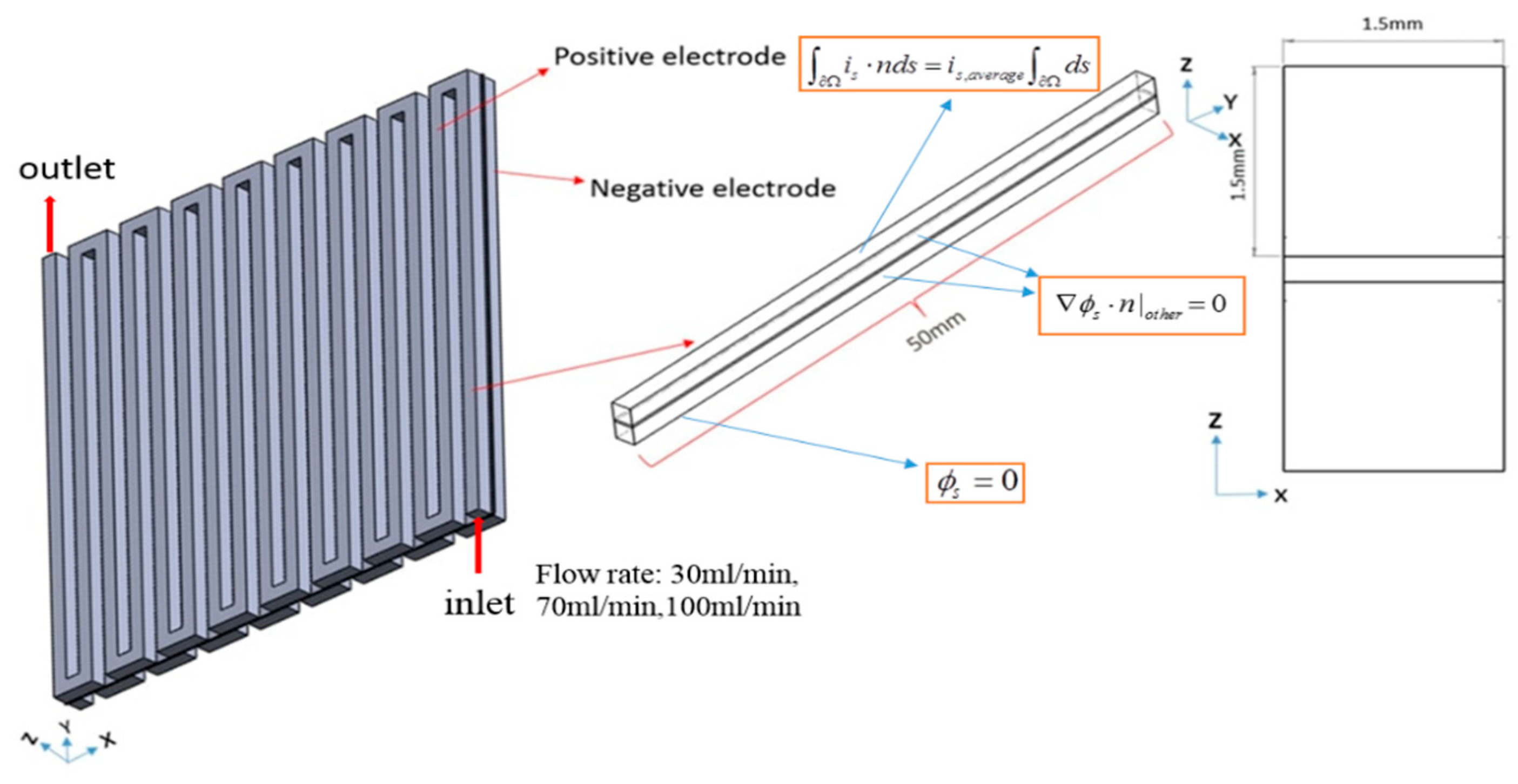

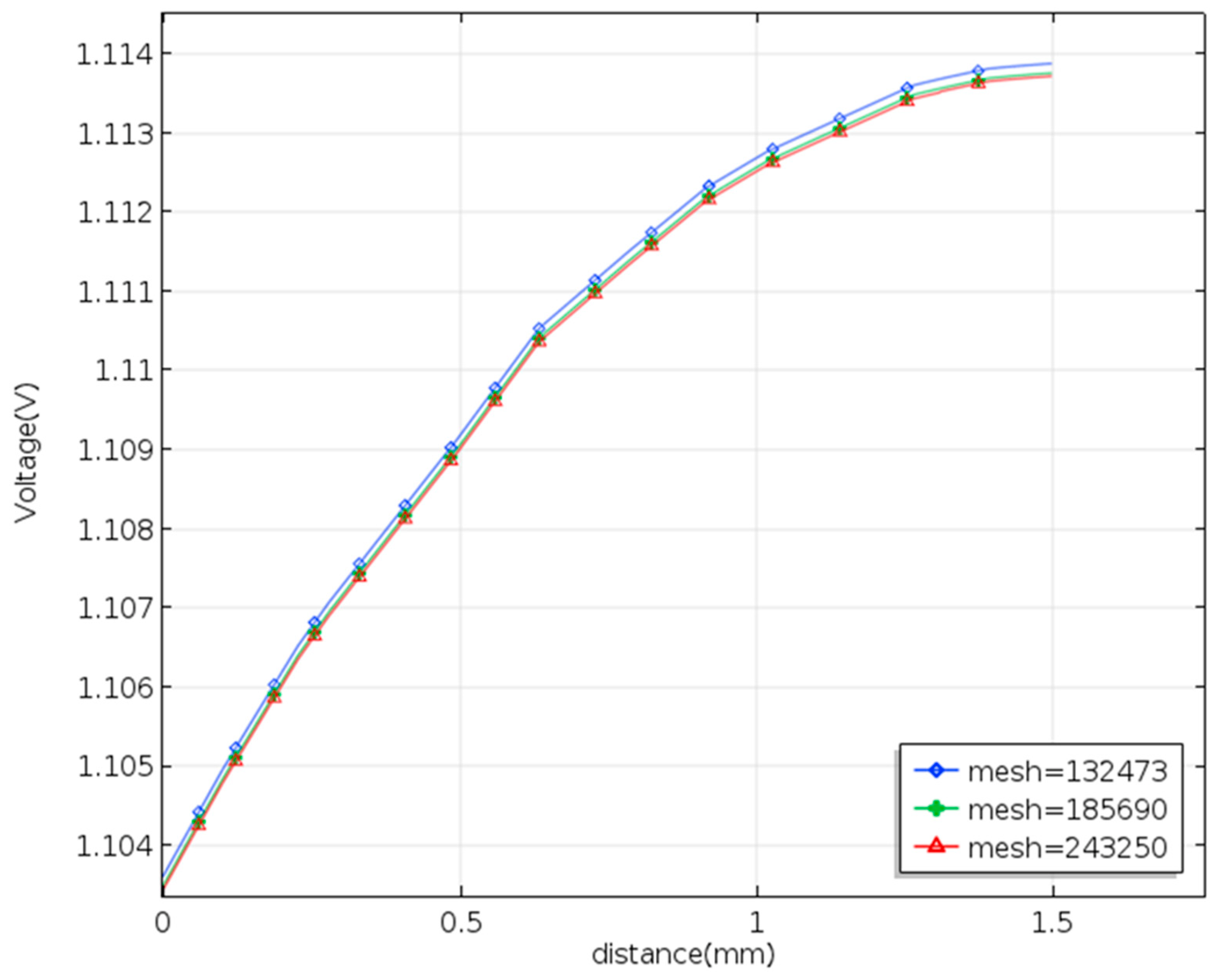

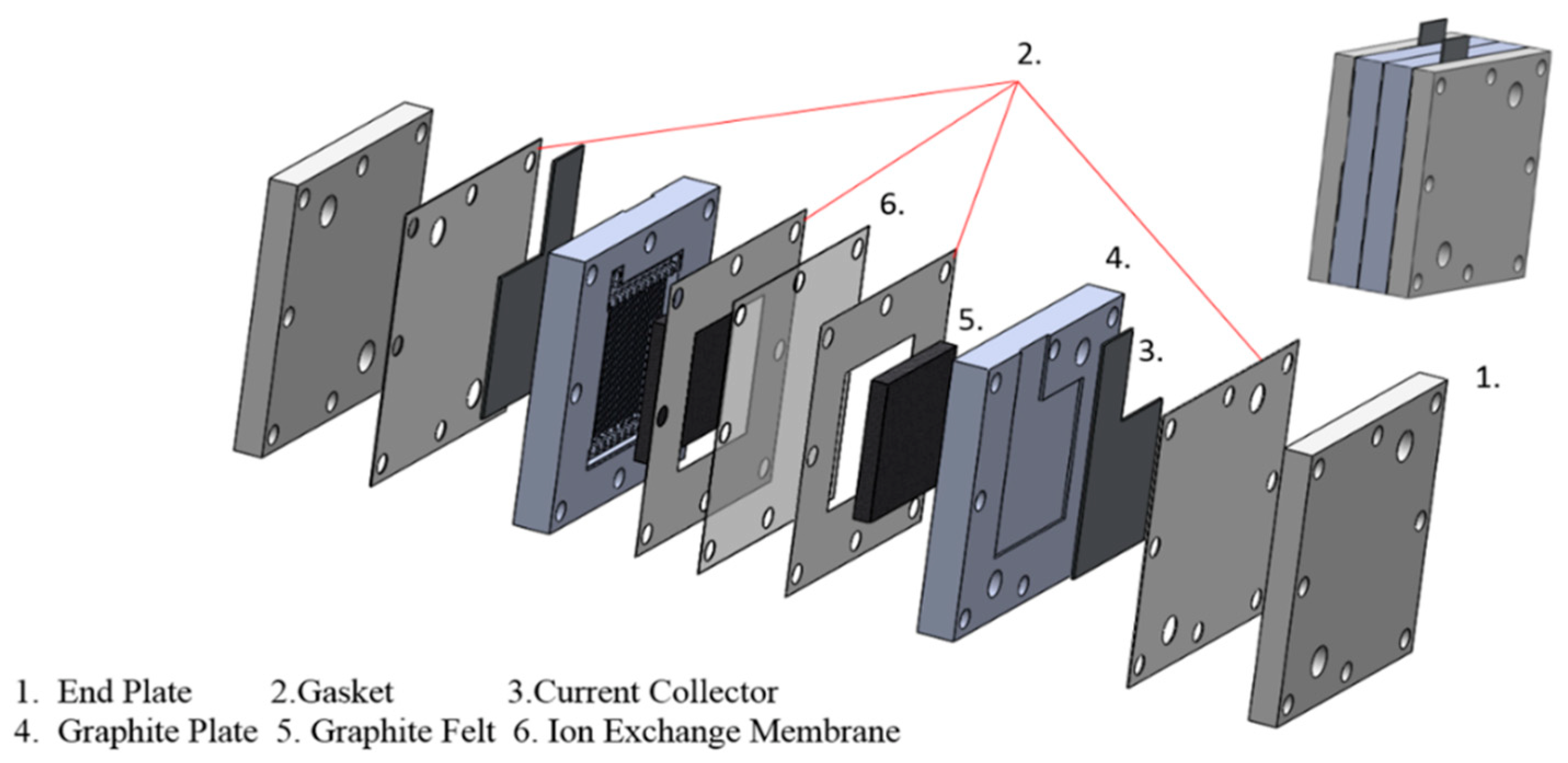


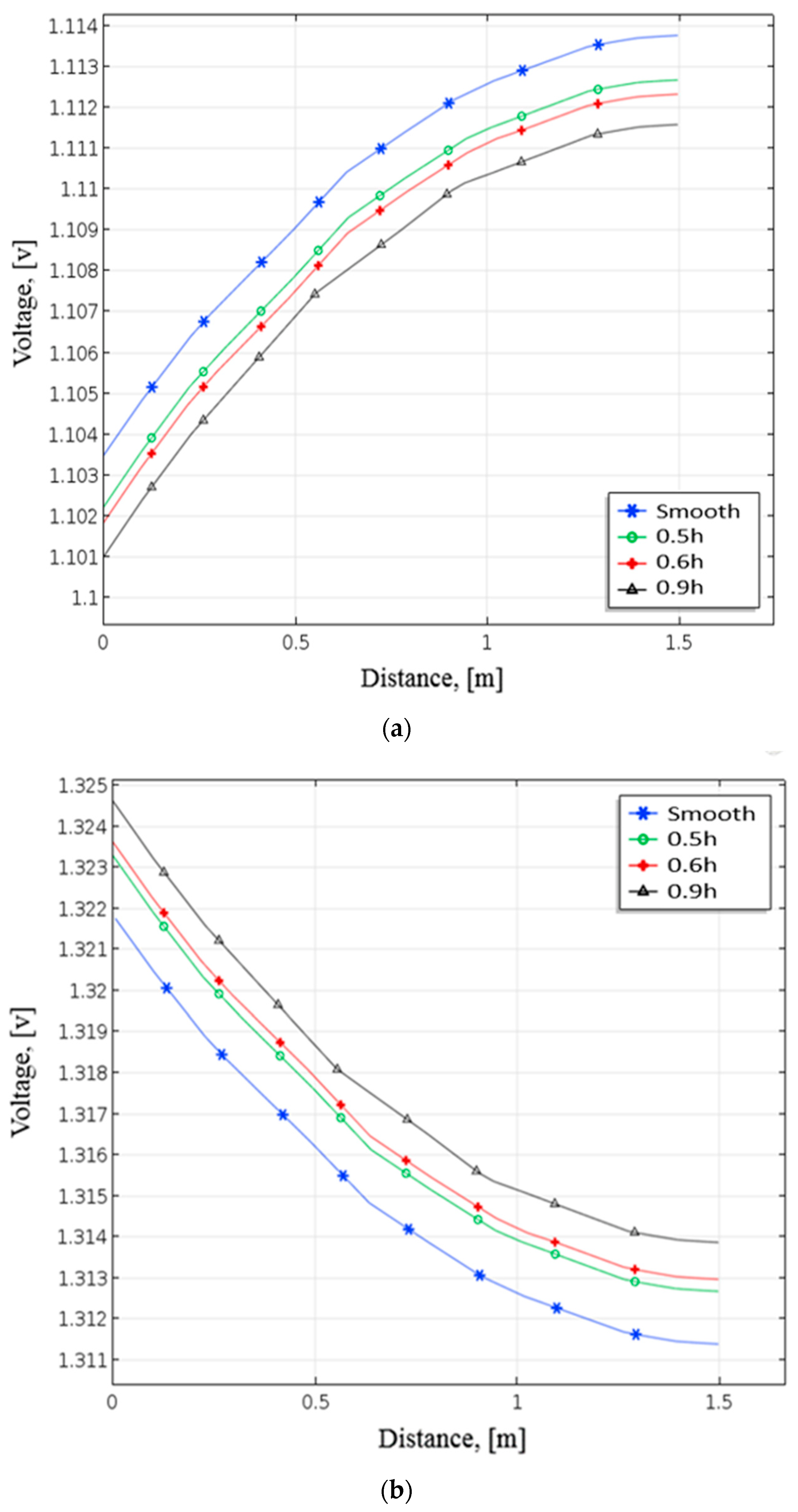
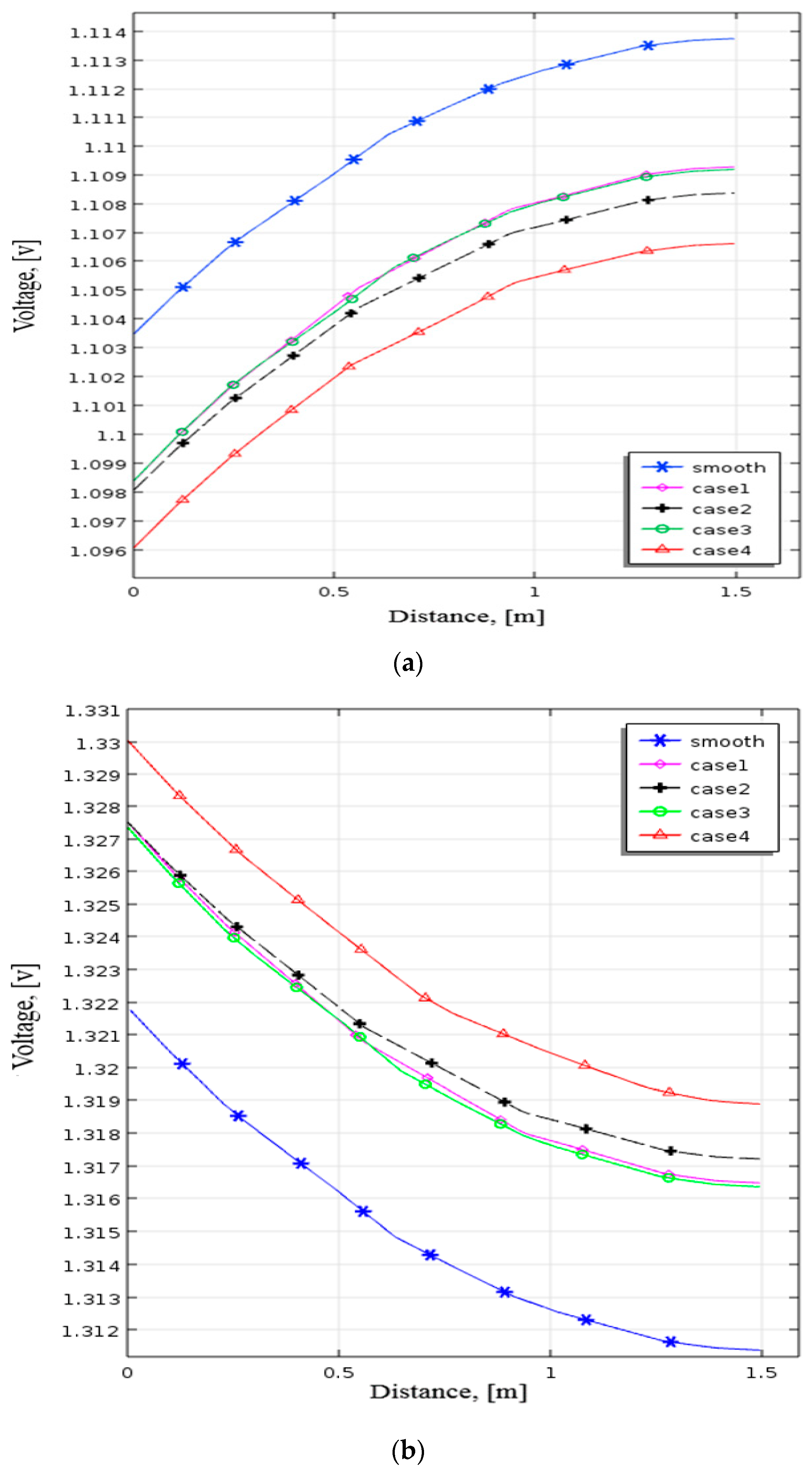
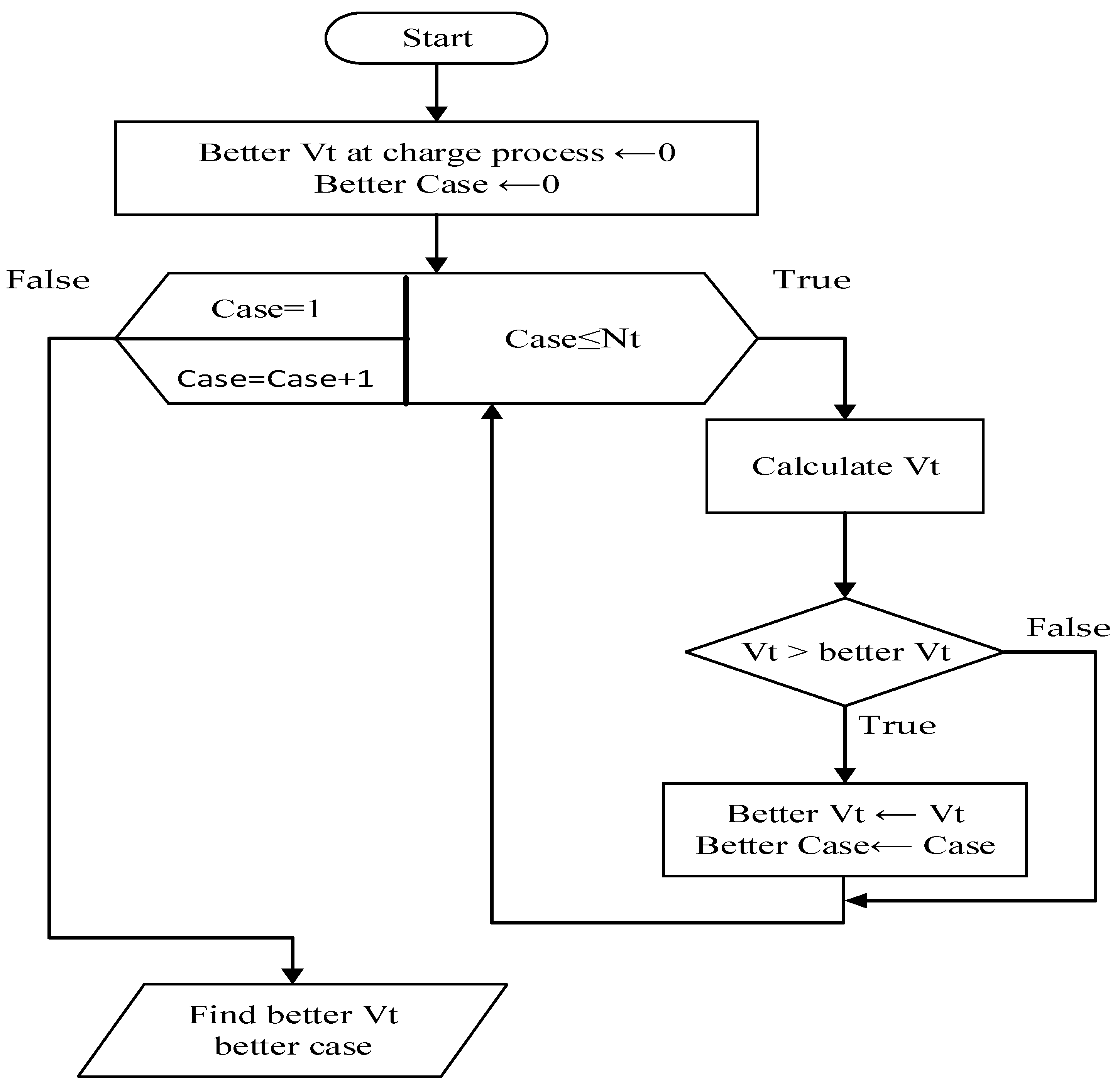

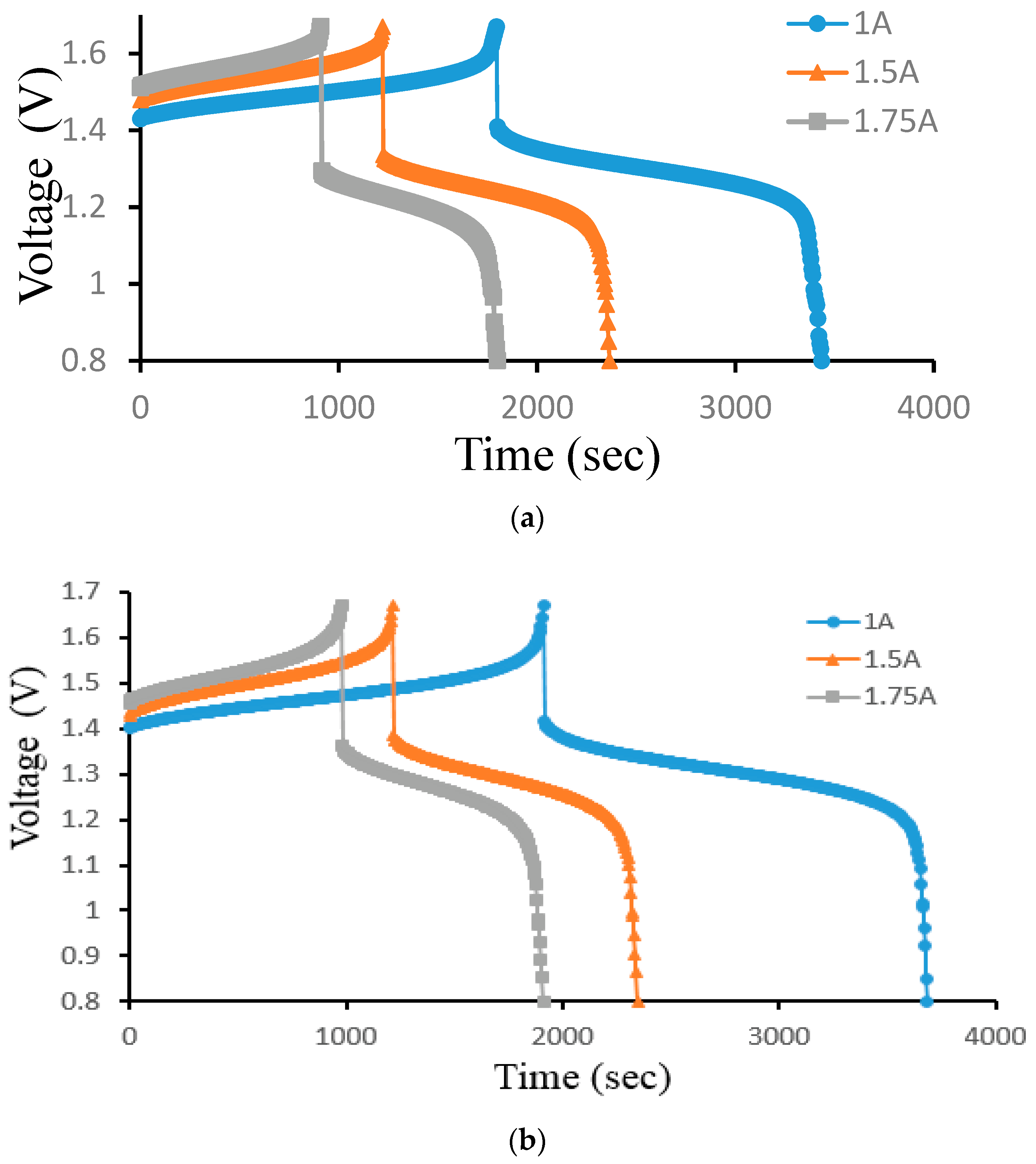
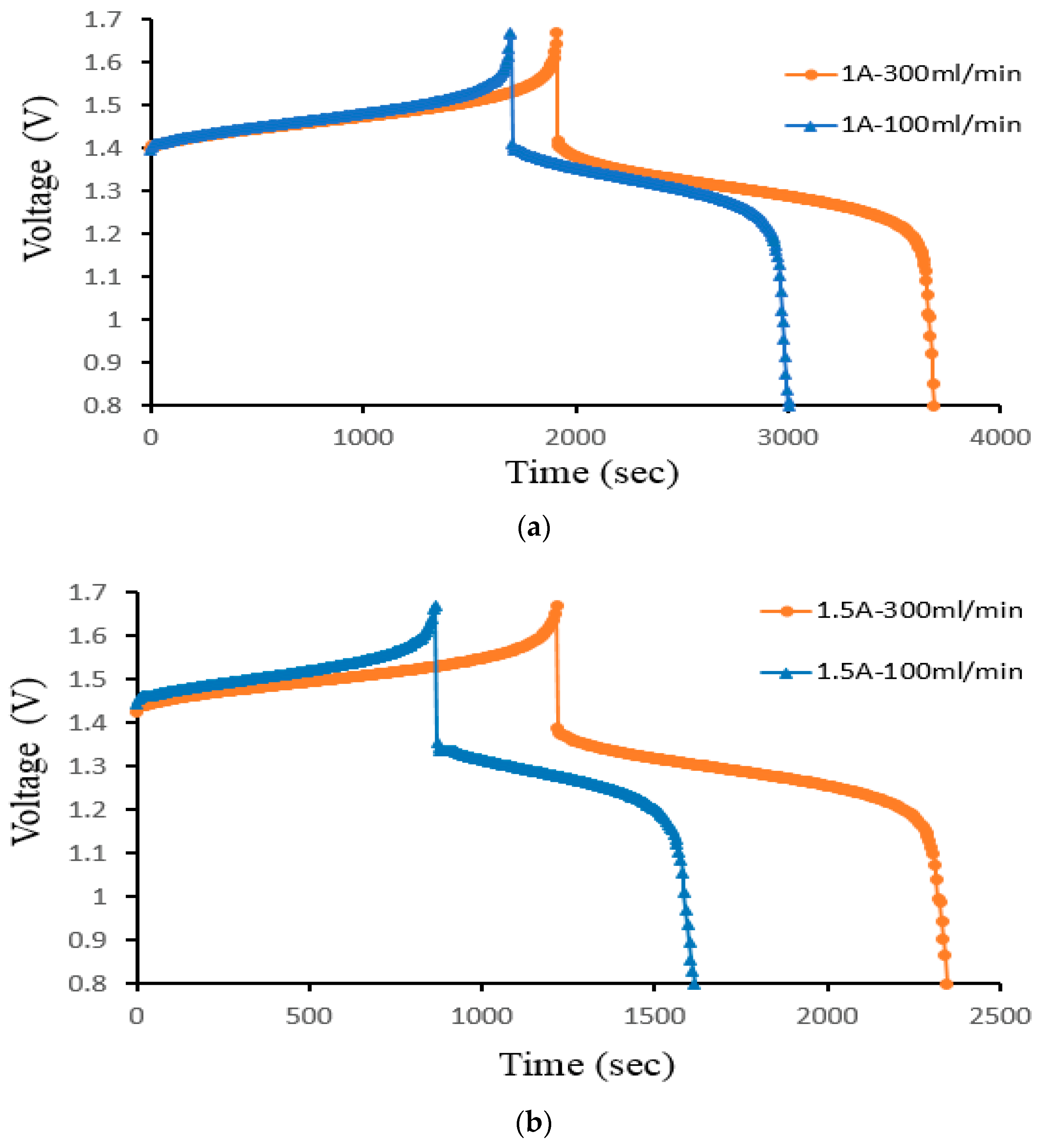

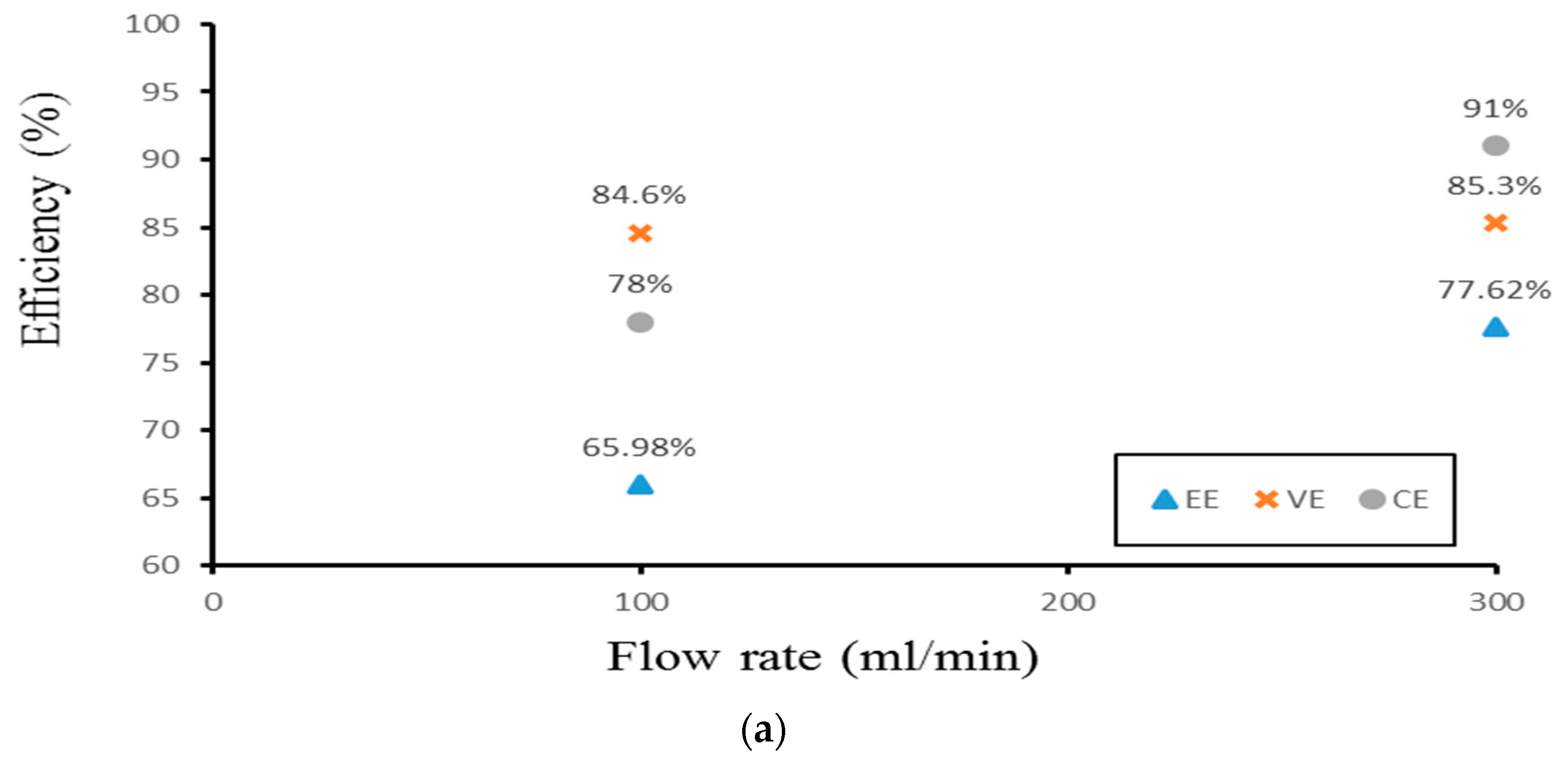



| Parameter | Symbol | Value | Unit |
|---|---|---|---|
| Electrode thickness | d | 0.0015 | m |
| Temperature | T | 293.15 | K |
| Electrode conductivity | 66.7 | S/m | |
| Electrode porosity | 0.93 | - | |
| Specific area | m−1 | ||
| Positive Standard potential | E0,pos | 1.004 | V |
| Negative Standard potential | E0,neg | −0.255 | V |
| Membrane thickness | - | 2.03 × 10−4 | m |
| Positive Transfer coefficient | 0.55 | - | |
| Negative Transfer coefficient | 0.45 | - | |
| Positive rate constant | m/s | ||
| Negative rate constant | m/s | ||
| initial concentration | 156 | mol m3 | |
| initial concentration | 884 | mol m3 | |
| initial concentration | 884 | mol m3 | |
| initial concentration | 156 | mol m3 | |
| Vanadium flow density | 1350 | kg/m3 | |
| Vanadium flow viscosity | 0.005 | Pa·s |
| Convection Mass Transfer Coefficient (m/s) | ion |
|---|---|
| Smooth | 1.59 × 10−10 |
| Case1 | 2.17 × 10−10 |
| Case2 | 2.26 × 10−10 |
| Case3 | 2.08 × 10−11 |
| Case4 | 3.28 × 10−10 |
| Item | Uncertainty |
|---|---|
| Flow rate | ±1.83% |
| Current density | ±0.05% |
| Voltage | ±0.47% |
| Voltage efficiency | ±0.16% |
| Coulombic efficiency | ±0.43% |
| Energy efficiency | ±0.52% |
Disclaimer/Publisher’s Note: The statements, opinions and data contained in all publications are solely those of the individual author(s) and contributor(s) and not of MDPI and/or the editor(s). MDPI and/or the editor(s) disclaim responsibility for any injury to people or property resulting from any ideas, methods, instructions or products referred to in the content. |
© 2023 by the authors. Licensee MDPI, Basel, Switzerland. This article is an open access article distributed under the terms and conditions of the Creative Commons Attribution (CC BY) license (https://creativecommons.org/licenses/by/4.0/).
Share and Cite
Wu, H.-W.; Zeng, Y.-K. Effect of Baffles in Flow Channel on the Performance of Vanadium Redox Flow Battery. Processes 2023, 11, 523. https://doi.org/10.3390/pr11020523
Wu H-W, Zeng Y-K. Effect of Baffles in Flow Channel on the Performance of Vanadium Redox Flow Battery. Processes. 2023; 11(2):523. https://doi.org/10.3390/pr11020523
Chicago/Turabian StyleWu, Horng-Wen, and Yi-Kai Zeng. 2023. "Effect of Baffles in Flow Channel on the Performance of Vanadium Redox Flow Battery" Processes 11, no. 2: 523. https://doi.org/10.3390/pr11020523







